Chai layer cake features three layers of chai infused cake frosted with vanilla bean Swiss buttercream.
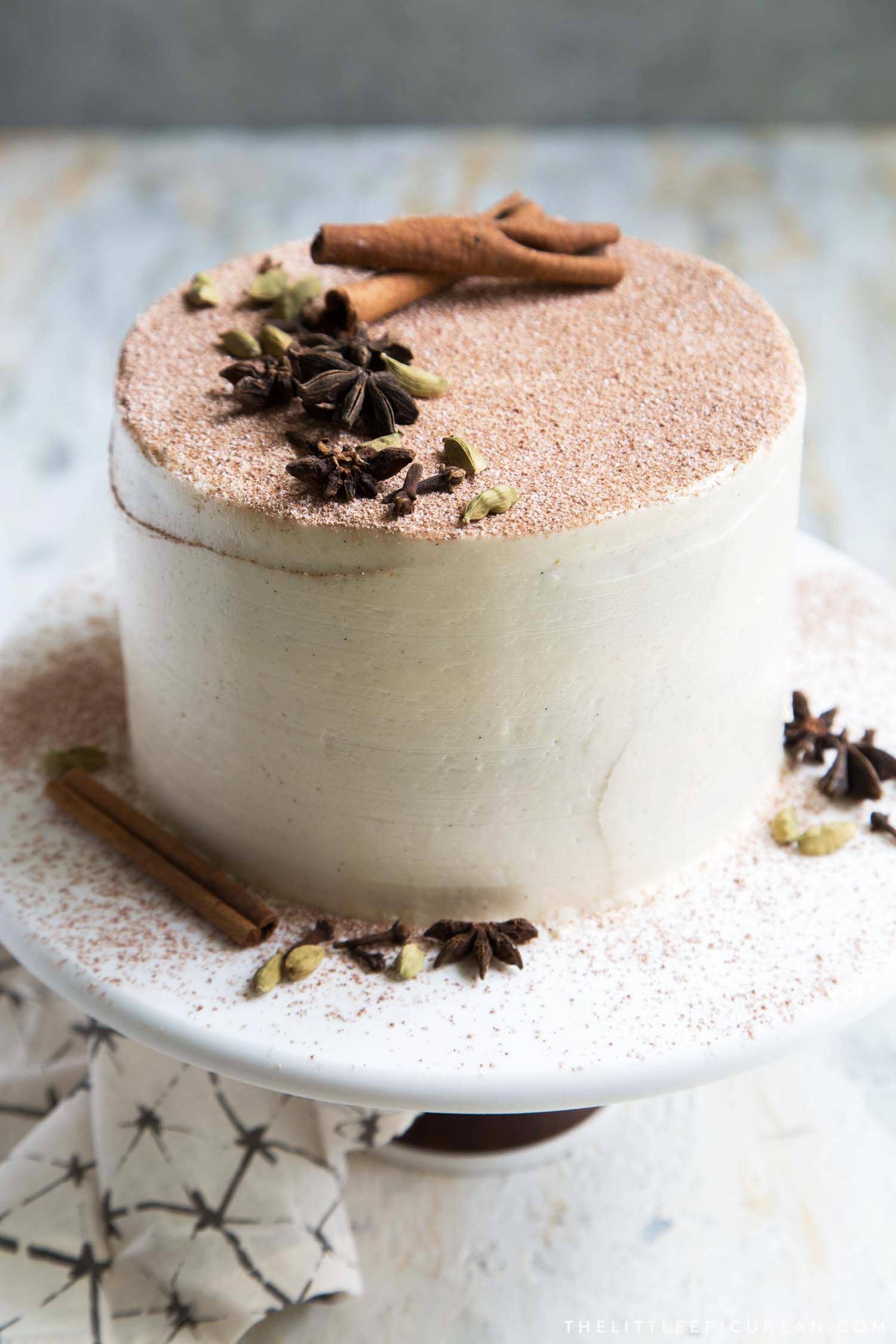
“Chai” is the Hindi word for tea. Masala chai refers to the blend of black tea, warm spices, and milk that has become very popular in the United States over the last decade.
This is probably thanks to Oprah and her namesake Oprah Cinnamon Chai Latte sold at Starbucks. Before I became a coffee drinker, I was obsessed with chai. Here is an ode to my favorite tea in cake form!
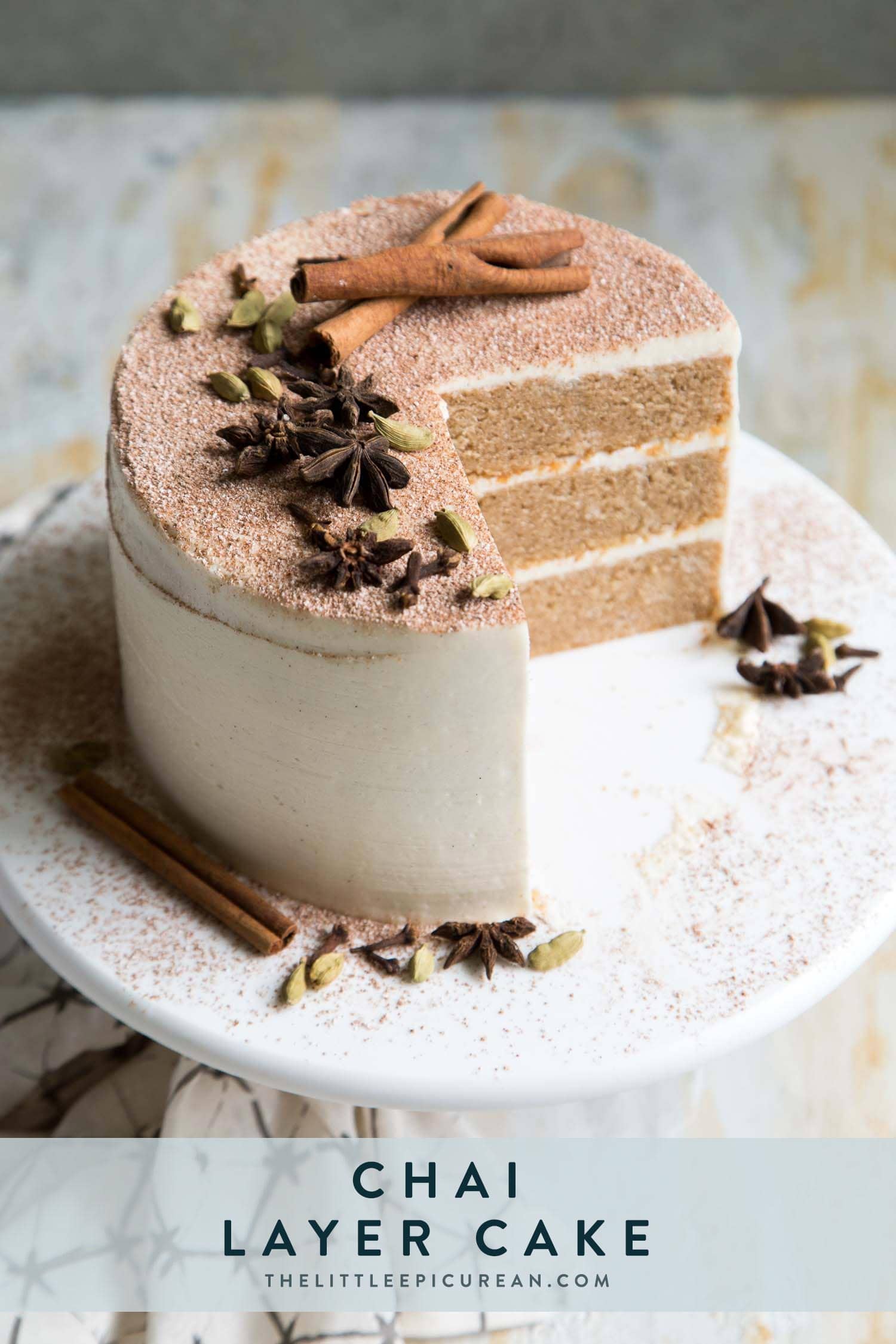
Chai Cake with Vanilla Bean Frosting
There are various versions of chai latte. It’s a mixture of black tea with some combination of spices.
Those spices usually include cardamom, ginger, cinnamon, cloves, and star anise. Sometimes, it also includes a dash of black pepper or nutmeg.
This chai layer cake is spiced with cinnamon, ginger, cardamom, and cloves.
But, most of the flavor and fragrance comes from the milk used in the cake batter. The milk is infused with these store-bought chai tea bags.
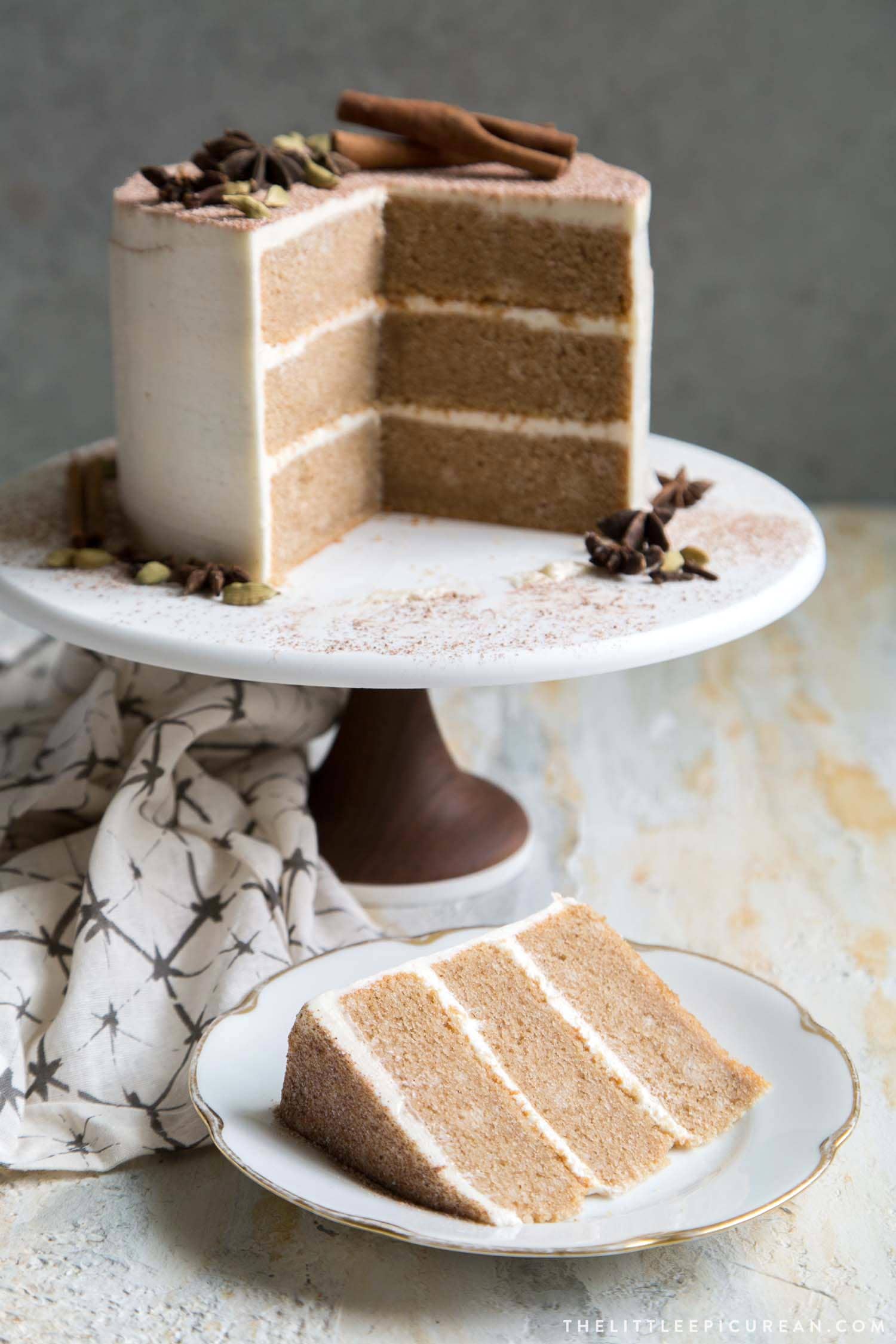
Creaming vs Reverse Creaming Method
There are several ways to mix together batters. Foaming technique is used for making angel food cake.
Store-bought cake mixes use the “all-in” or one bowl approach in which all the ingredients are simply mixed together all at once.
Cookies and quick breads use the traditional creaming method. It’s the most commonly used mixing process.
Butter and sugar are beat together until light and fluffy. Eggs are added. And then, the liquids and dry mixture follow.
Creaming method traps air during mixing, allowing the batter to rise and expand during baking.
This chai layer cake batter is mixed together using reserve creaming.
What is the reverse creaming method?
As the name suggests, reverse creaming is the opposite of traditional creaming. It is also known as the paste method or two-stage creaming method.
In this method, the dry ingredients are first whisked together. Then, butter is added and combined with the dry ingredients until the mixture resembles crumbly, coarse sand.
Eggs and any remaining liquids are then added until the mixture is thick and smooth.
The reverse creaming method produces cakes with little to no air pockets. The baked cake may not rise as high as a creamed method cake batter, but the cake itself is much softer and more tender.
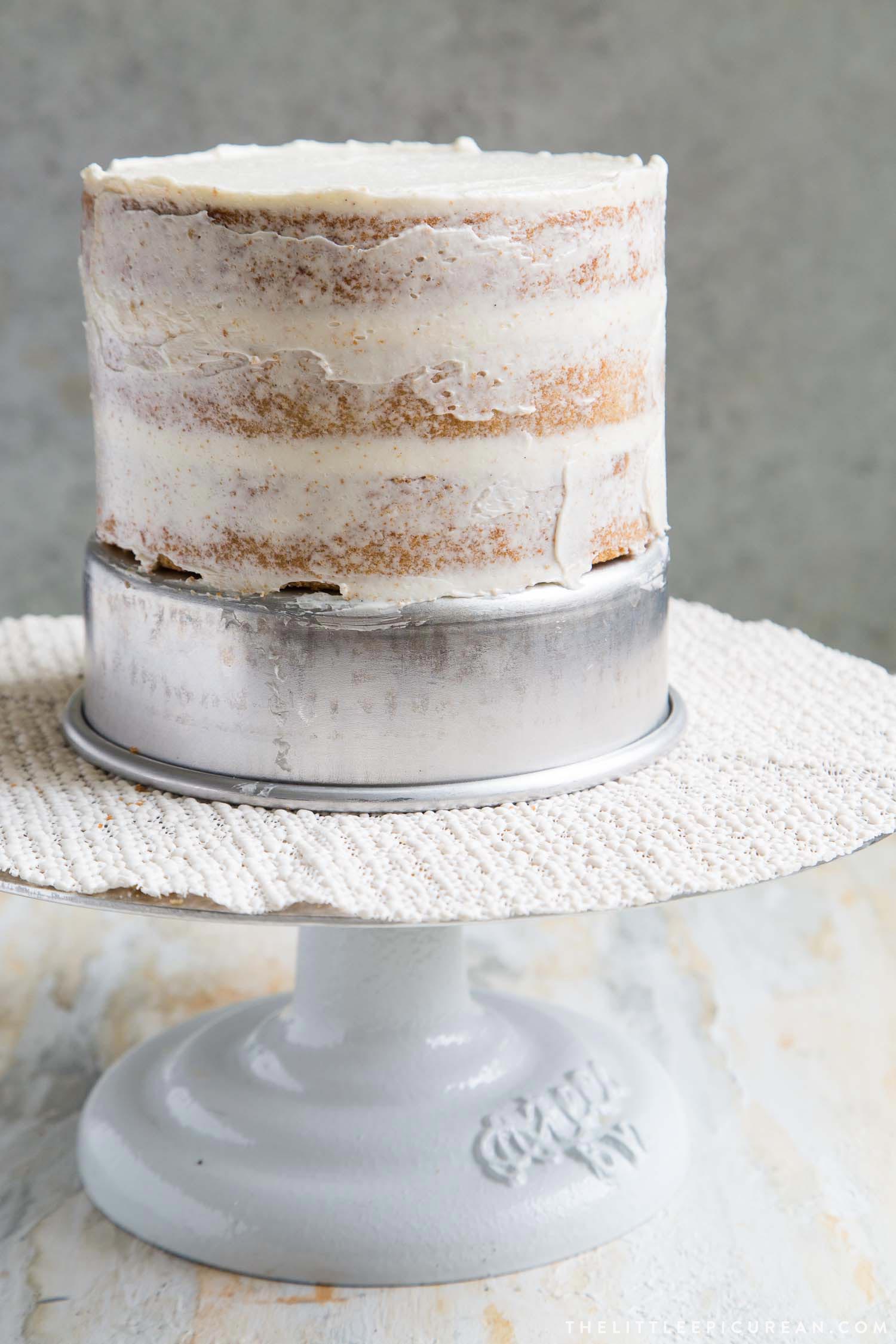
Why crumb coat layer cakes?
A light coating of buttercream seals in any stray or loose cake crumbs. But more importantly, the crumb coat layer helps to build the foundation of the cake.
After application of the crumb coat layer, the cake is allowed to chill in the fridge and the buttercream hardens a bit. This helps to ensure the structurally integrity of the multi-layer cake.
When it’s time to add the second or final coat of buttercream, the cake layers are stable. The cake layers won’t wobble or tilt to the side.
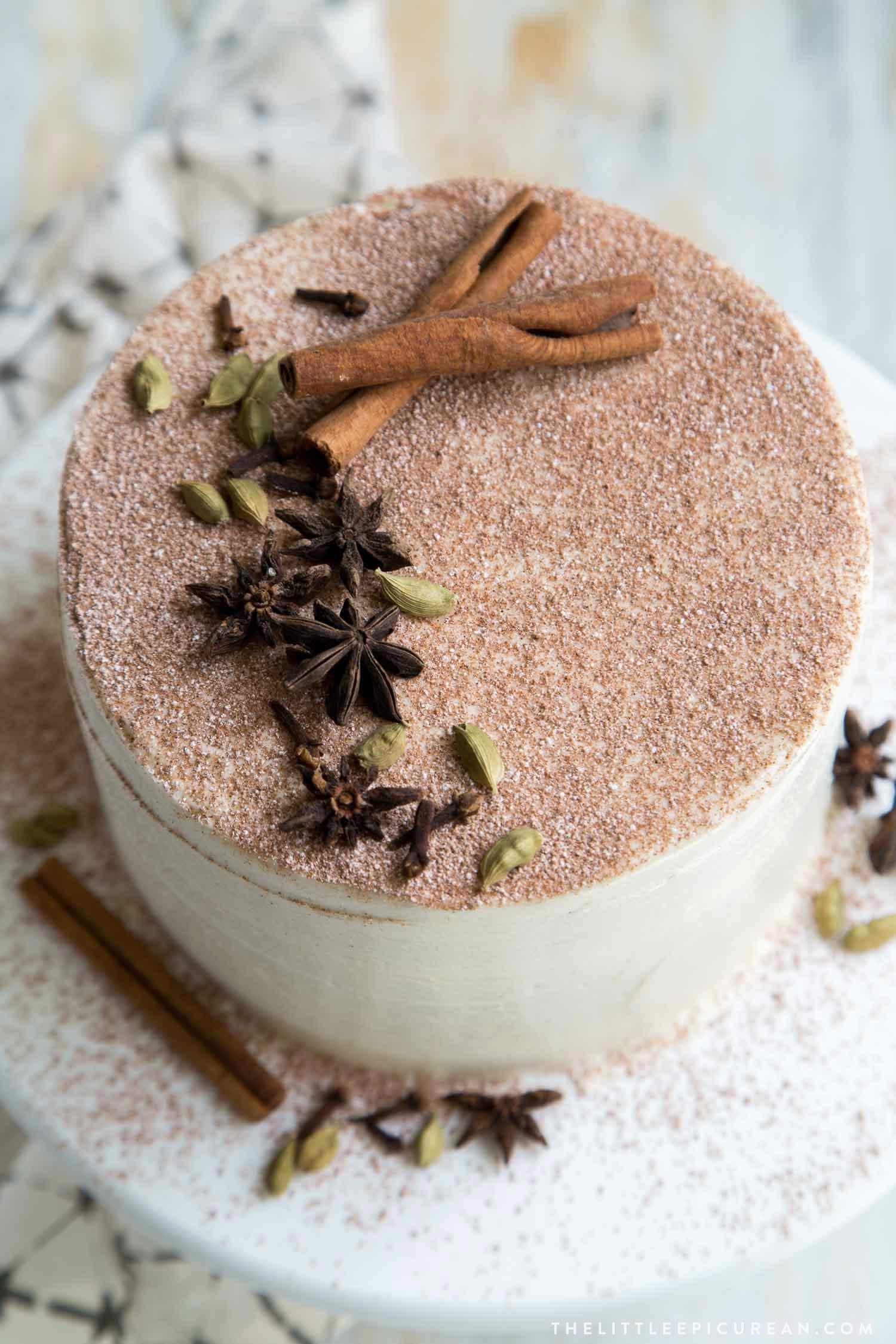
American Buttercream vs Swiss Buttercream
Swiss buttercream requires a bit more work than the standard American buttercream. However, the effort is well worth it for this Chai Layer Cake!
In order to allow the chai flavors to truly shine in this cake, I needed to use a frosting that is light on the palette.
American buttercream is creamed mixture of butter and powdered sugar. It is a bit dense and quite sweet. The texture and sweetness would overpower the chai flavors.
Swiss buttercream is made by melting sugar in egg whites. The mixture is whipped like a meringue and then softened butter is mixed in. The resulting buttercream is light and airy.
Swiss buttercream provides the perfect balance to this delicate chai cake.
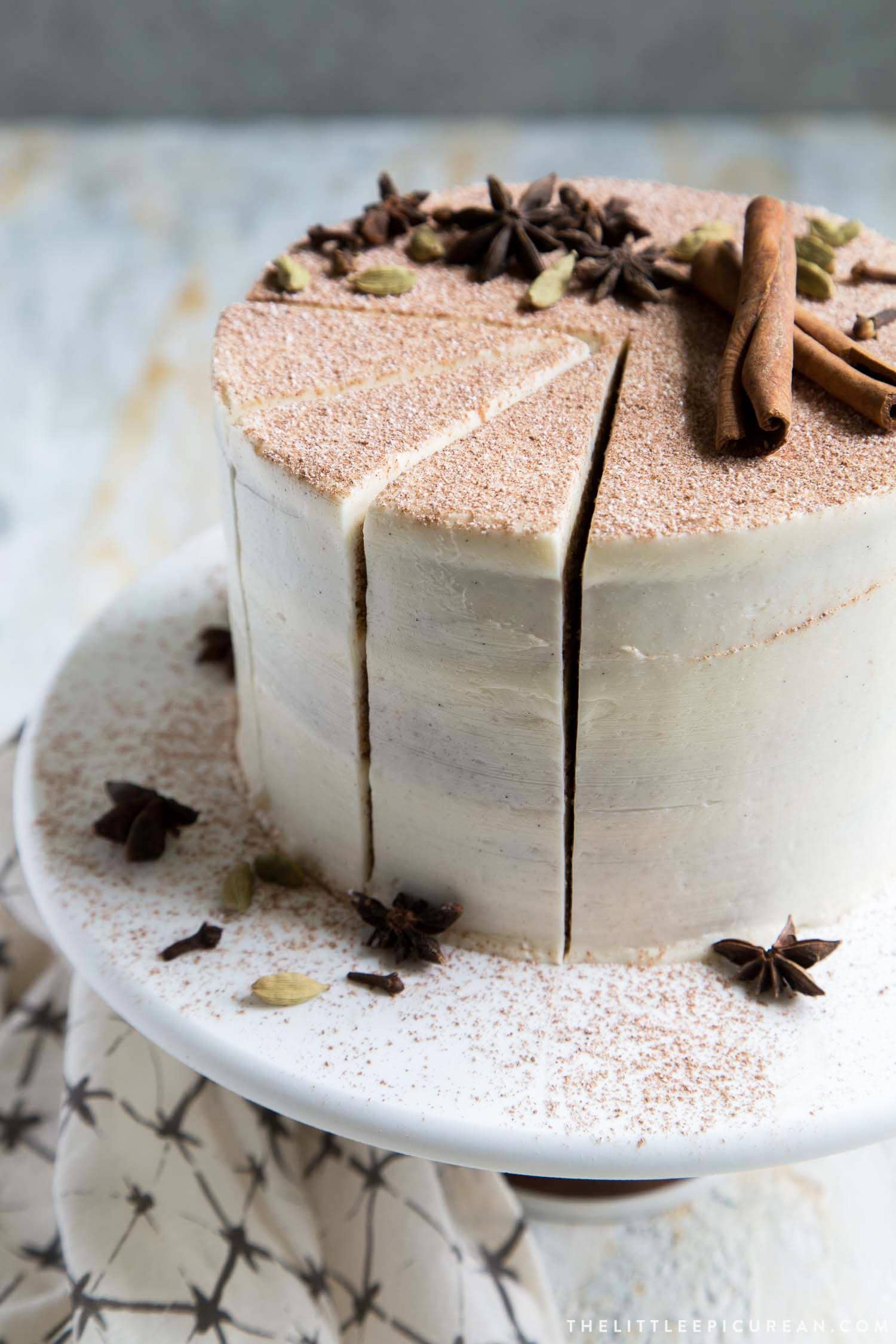
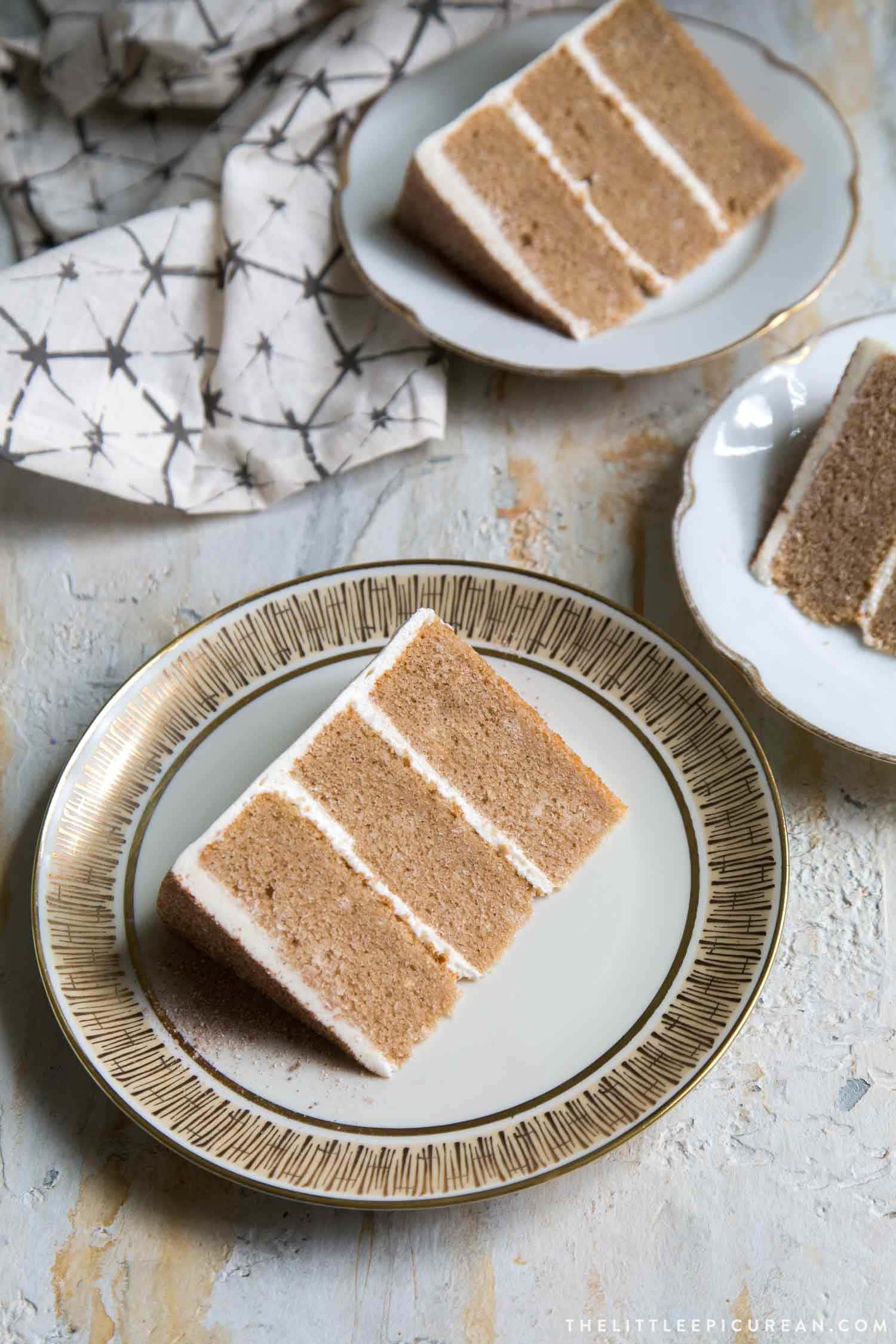
Not a fan of chai spices? The method of steeping tea in milk can be used for other flavors. Try making an earl grey cake or a sweet black milk tea cake!
MAKE AHEAD: Cake Making Over Several Days
Day 1: Make the chai cake batter. Bake off cake. Cool cake to room temperature. Tightly wrap in plastic wrap and keep at room temperature overnight (up to two days).
Day 2: Make the Swiss buttercream. Immediately use the Swiss buttercream to assemble the cake. OR, store buttercream in an airtight container in the fridge overnight.
Optional Day 3: Take buttercream out of the fridge. Let sit at room temperature for several hours until buttercream has softened. Revitalize buttercream using a sturdy whisk or beat with paddle attachment in stand mixer until smooth, light, and fluffy. Assemble cake as directed in instructions.
NOTE: For even longer prep period, tightly wrap cooled cake in double plastic wrap. Store in the freezer for up to a month. Be sure to freeze cake on a flat level surface. Defrost wrapped cake overnight at room temperature.
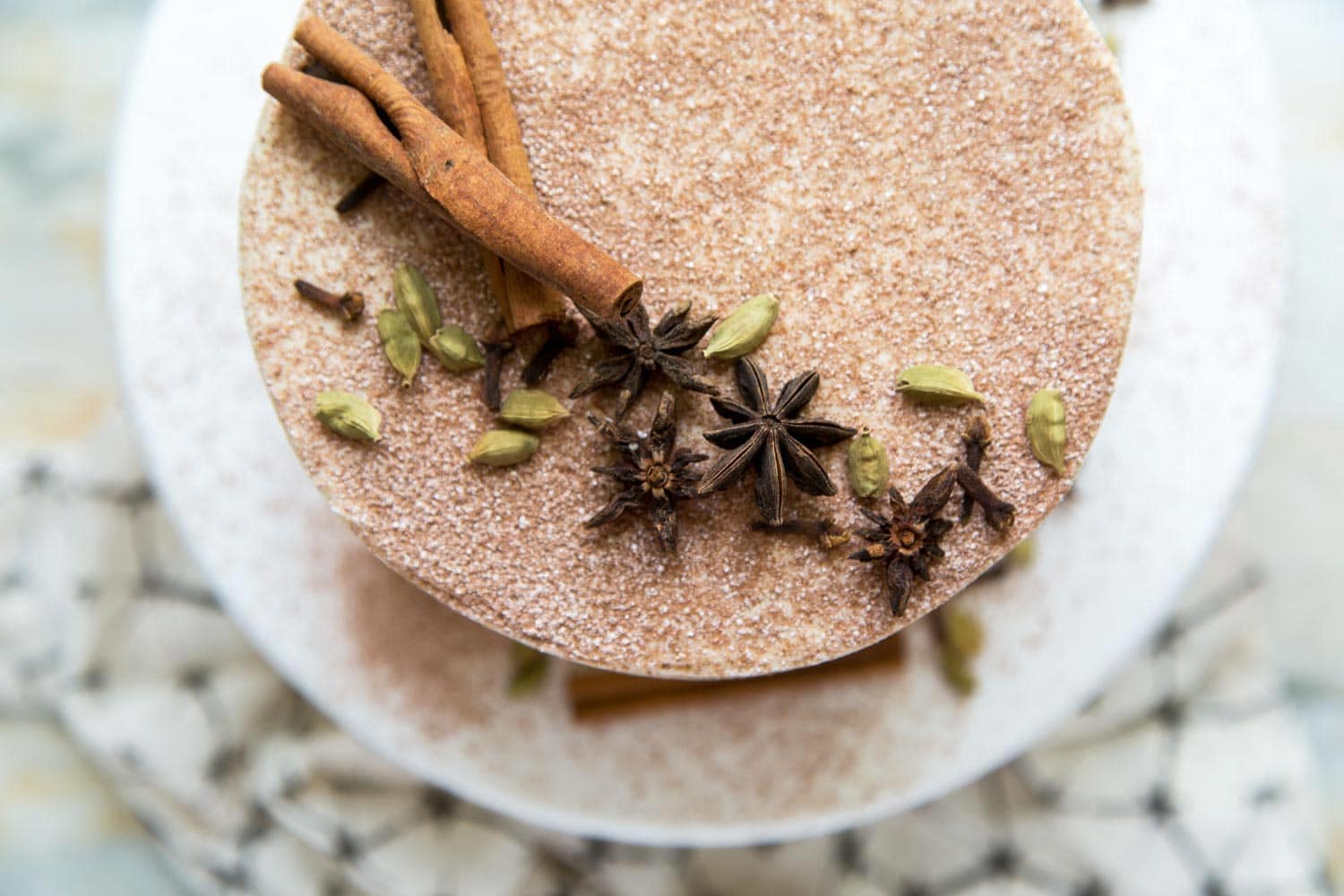
More Tea Flavored Desserts
Chai Layer Cake
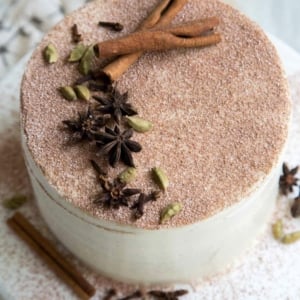
Ingredients
Chai Cake:
- 1 cup whole milk
- 4 chai tea bags
- 2 ½ cup cake flour
- 1 ¼ cup granulated sugar
- 2 teaspoon baking powder
- ½ teaspoon kosher salt
- 1 teaspoon ground cinnamon
- ¼ teaspoon ground ginger
- ¼ teaspoon ground cardamom
- ¼ teaspoon ground cloves
- 1 cup unsalted butter,, room temp
- 3 large eggs, , room temp
- 2 teaspoon pure vanilla extract
Swiss Buttercream:
- ½ cup egg whites
- 1 ½ cup granulated sugar
- 2 cup unsalted butter,, sliced into tablespoons, room temp
- ½ teaspoon kosher salt
- ½ Tablespoon vanilla bean paste*
Dusting Powder:
- 2 Tablespoon powdered sugar
- 1 teaspoon unsweetened cocoa powder
- 1 teaspoon ground cinnamon
Instructions
Chai Cake:
- Bring milk to a boil and remove from heat. Add tea bags and steep for 30 minutes. Strain out tea. Squeeze out as much liquids from the tea as possible. Discard tea bags. Measure remaining liquid. Add additional milk as necessary until you have 1 cup of liquid. Set aside.
- Preheat oven to 350 degrees F. Butter three 6-inch round cake pans. Line with parchment paper and set aside.
- In the bowl of stand mixer fitted with paddle attachment, combine 2 cups flour (reserve remaining 1/2 cup flour), sugar, baking powder, salt, cinnamon, ginger, cardamom, and cloves. Add butter in three additions. Continue to mix on low speed until mixture is crumbly like coarse sand.
- In another bowl, whisk together tea infused milk, eggs, and vanilla until smooth. Add half of liquid mixture to stand mixing bowl. Mix on medium speed until incorporated. Add remaining liquid mixture and mix until batter is combined. The batter will look curdled. Add reserved 1/2 cup of flour and mix until batter comes together.
- Evenly distribute batter among prepared cake pans. Bake for 30-35 minutes until toothpick inserted in center of cake comes out clean. Allow cake to cool in pan for 10-15 minutes. Run an offset spatula along the sides of the cake pan to loosen cake. Invert cake onto a wire rack and allow to cool to room temperature.
Swiss Buttercream:
- In the bowl of a stand mixer, whisk together egg whites and sugar. Place bowl over a pot of simmering water to create a bain-marie or double boiler. Make sure the simmering water does not touch the bottom of the bowl. Whisk sugar-egg mixture until it reaches a temperature of 160 degrees F.Alternatively, if you don’t have a thermometer, heat the mixture until all the sugar has melted. Test this by dipping your pointer finger into the mixture and rubbing it against your thumb. The mixture should be smooth. You should not be able to feel the granules of sugar.
- Return bowl to the stand mixer. Using the whisk attachment, beat mixture at medium speed until it has cooled to room temperature and meringue has started to from. Reduce speed to low and add butter one tablespoon at a time.
- Once all the butter has been incorporated, add salt. Increase speed to medium-high and continue to beat until buttercream is light and fluffy. Add in vanilla bean paste and mix until distributed.
Assembly:
- Level cake layers as necessary. Place one cake layer on serving platter or cake turntable. Spread about 1/3 cup of buttercream on cake. Place second cake layer and repeat adding butter. Repeat with third cake layer.
- Spread a layer of buttercream around the sides of the cake to seal in the crumbs (crumb coat). Place cake in the fridge and allow to chill for 15 minutes to set the buttercream.
- Add another layer of buttercream as desired. Garnish with dusting powder and spices as desired.
- Dusting Powder: In a small bowl, whisk together powdered sugar, cocoa powder, and cinnamon. Sift mixture over assembled cake as desired.
Notes
- I use vanilla bean paste for a richer vanilla flavor. Also, because I like seeing the little speckles of vanilla bean throughout the buttercream. Substitute high quality vanilla extract if you don’t have vanilla paste.
- I used these Tazo Chai Tea Bags
Nutrition
Nutrition information is automatically calculated, so should only be used as an approximation.
 Like this recipe? Rate & comment below!
Like this recipe? Rate & comment below!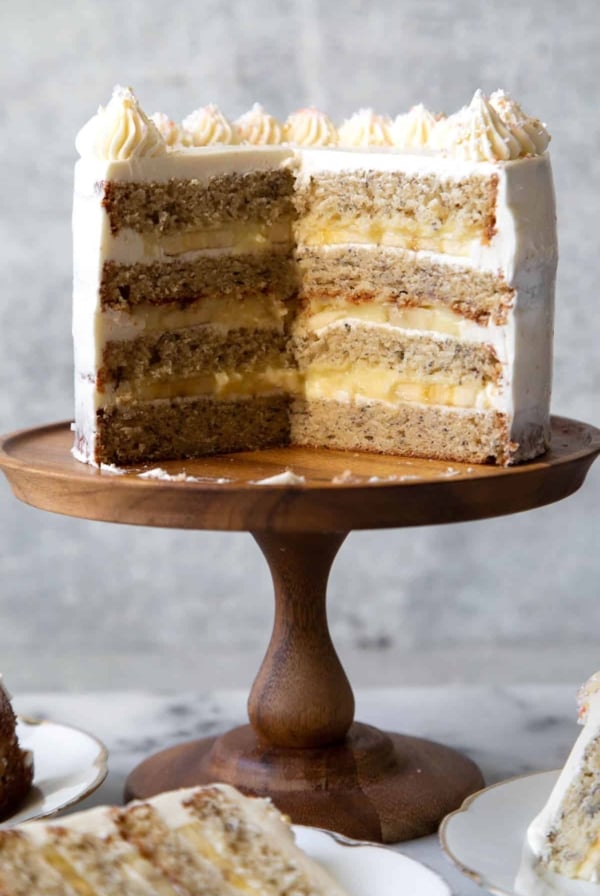
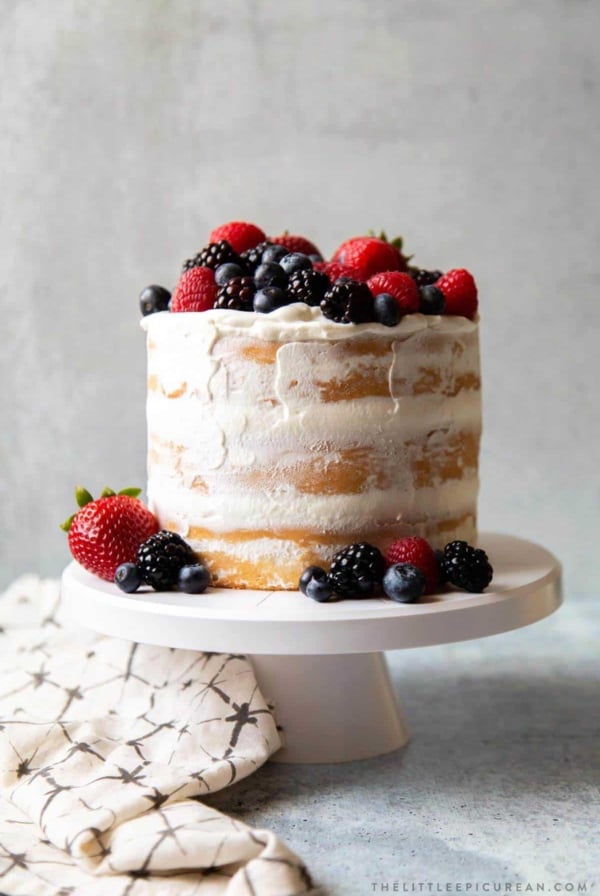
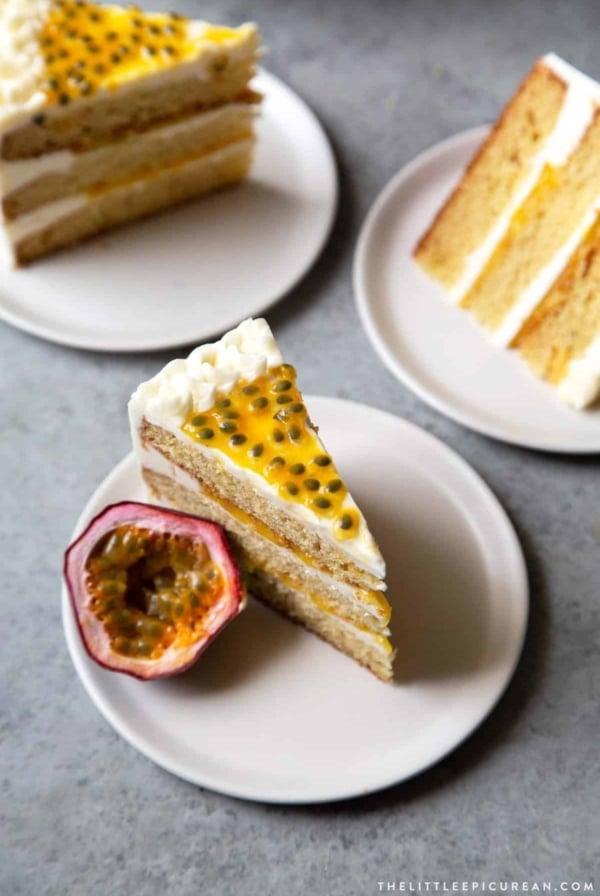
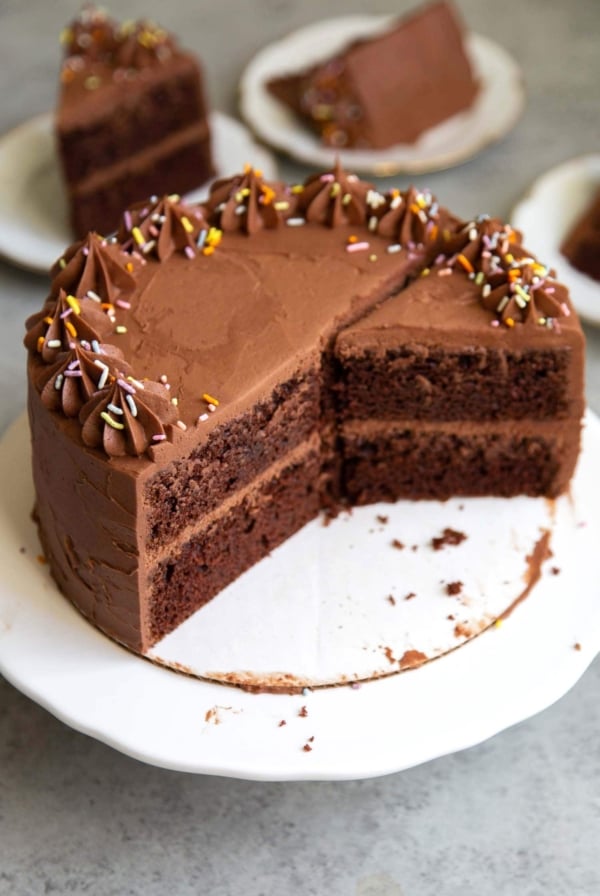





If you use the crumb coat method, do you need to make the frosting in 2 batches? Won’t the frosting harden while you wait for the cake to firm up in the fridge?
Swiss buttercream does not harden or form a crust the way that American buttercream does when left out.
The cake was dense and dry. Extremely flavorful. The frosting I will never do again. It was legit butter. I whisked for over 10 minutes and the taste of butter did not dissipate. There are better buttercream frosting recipe alternatives. The melting of the sugar in the egg whites was so tedious and unnecessary. I did enjoy the chai flavor above all.
Lovely cake! Flavours were beauitful! The house actually smelt like donuts whilst baking, it was divine! Deffinitely adding this to the favourites ?
This cake Looks so good! Can I substitute the flour for a gluten free flour mixture?
Hi! I have not tested this recipe using gluten-free flour.
Hi,
Can the cake be baked in one 6 inch pan instead of three separate pans?
I recommend baking the cake in three separate pans. If you try to bake it all in one tall 6-inch pan, it will take much longer to fully bake. As a result, the cake will be dry.
Hey!..I dont like buttercreams usually as i dont like my frostings to be very buttery..will it be ok if i add just 1 cup butter to the frosting?
No, you cannot adjust the amount of butter in the Swiss buttercream. Without the proper amount of butter, the buttercream will not whip together. If you don’t like butter, I suggest using a different frosting.
Hi! I love this recipe and am very excited to use this soon to surprise my boyfriend with a cake for our 3-year anniversary. He loves chai!
Due to my work schedule, I need to make this cake a couple of days in advance. I appreciate the day breakdown you provided! Do you have a recommendation for storing it once it’s been fully assembled? I’m not sure if freezing, refrigerating, or leaving at room temperature will keep it fresh the longest. Thank you! :)
I do not recommend freezing the assembled cake. I would freeze the cooled baked cake and Swiss buttercream separately. Defrost everything overnight and then assemble up to one day before serving. Store in the fridge in a cake box. Let sit at room temperature for at least 1 hour before serving to soften cake and buttercream.
Hello, I’m wondering if any parts of this cake could be prepared in advance and, if so, how far in advance and any advice such as bringing to a certain temperature if refrigerated.
Great question! I have updated the post to include tips on breaking down cake making over several days.